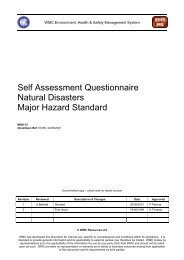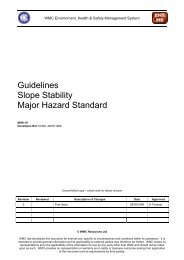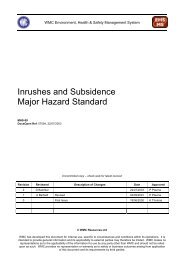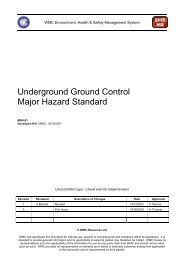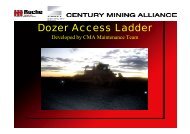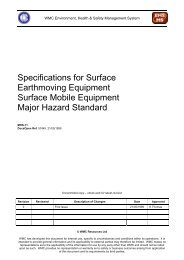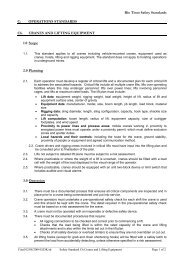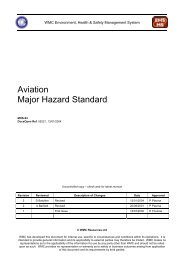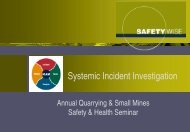Surface Mobile Equipment Major Hazard Standard - MIRMgate
Surface Mobile Equipment Major Hazard Standard - MIRMgate
Surface Mobile Equipment Major Hazard Standard - MIRMgate
- No tags were found...
Create successful ePaper yourself
Turn your PDF publications into a flip-book with our unique Google optimized e-Paper software.
WMC Environment, Health & Safety Management System<strong>Surface</strong> <strong>Mobile</strong> <strong>Equipment</strong><strong>Major</strong> <strong>Hazard</strong> <strong>Standard</strong>MHS-11DocsOpen Ref: 57101, 16/10/2001Uncontrolled copy – check web for latest revisionRevision Reviewed Description of Changes Date Approved1 A Barfield Revised 16/10/2001 P Plavina0 First Issue 19/06/2000 K Thomas© WMC Resources LtdWMC has developed this document for internal use, specific to circumstances and conditions within its operations. It isintended to provide general information and its applicability to external parties may therefore be limited. WMC makes norepresentations as to the applicability of the information for use by any party other than WMC and should not be reliedupon as such. WMC provides no representation or warranty as to safety or business outcomes arising from applicationof this document and its requirements by third parties.
<strong>Major</strong> <strong>Hazard</strong> <strong>Standard</strong><strong>Surface</strong> <strong>Mobile</strong> <strong>Equipment</strong>PURPOSE AND SCOPE...........................2DETAILS ...................................................21 Introduction...........................................22 Planning and Design ............................22.1 Risk Assessment and Control............22.2 <strong>Equipment</strong> Specifications...................22.3 Modifications and Change..................23 <strong>Equipment</strong> .............................................23.1 Acceptance ........................................23.2 Warning Lights ...................................33.3 Maintenance ......................................33.4 Disposal .............................................34 Roads.....................................................34.1 General Requirements.......................34.2 Haul Roads ........................................44.3 Off-Mine Site Haul Roads Controlledby WMC............................................44.4 Infrastructure Roads ..........................44.5 Pit Access Roads...............................44.6 Tipping Areas and Stockpiles.............45 Operations ............................................ 45.1 Traffic Management Plan ...................45.2 Loads .................................................55.3 Visibility ..............................................55.4 Emergency Response........................55.5 Housekeeping ....................................55.6 Lighting...............................................56 Competencies....................................... 56.1 Operation of SME...............................56.2 Maintenance of SME..........................56.3 Induction.............................................66.4 Fitness for Work .................................6APPENDICES ........................................... 7A Definitions.................................................7B Related Documents ..................................8C Revision Information.................................8D Minimum Safety Requirements for SME 10SAF-MHS-11 Rev. 1 DOCS No. 57101 Issued:19/06/00 Page 1 of 11
<strong>Major</strong> <strong>Hazard</strong> <strong>Standard</strong><strong>Surface</strong> <strong>Mobile</strong> <strong>Equipment</strong>PURPOSE AND SCOPEThe purpose of this standard is to eliminate fatalitiesand serious injuries associated with the use of<strong>Surface</strong> <strong>Mobile</strong> <strong>Equipment</strong> (SME).This standard applies to all WMC and contractoremployees and visitors, and covers:• WMC surface mining operations• WMC processing plants• Off-mine site haul roads controlled by WMC.This standard is to be used in addition to theprovisions of any prevailing statutory requirementsIt does not cover:• Slag or molten material haulage(see SAF-MHS-04)• Heavy haulage on public highways.• Cranes whilst they are being used for liftingpurposes• Rail mounted vehicles.Where the provisions of this standard interface witheither the General Vehicles SAF-MHS-06 orUnderground <strong>Mobile</strong> <strong>Equipment</strong> SAF-MHS-05<strong>Standard</strong>s, the General Manager shall develop asystem that ensures the standard to be followed isclearly identified for each situation.DETAILS1 IntroductionThe safe operation of SME is achieved by the use offit-for-purpose equipment, on fit-for-purpose roadsby competent persons who are fit for duty using<strong>Standard</strong> Work Procedures (SWPs).This standard is intended to eliminate fatalities andserious injuries by developing:• Prevention strategies and procedures• Monitoring systems• Contingency plansand implementing them through the planning anddesign process to:• <strong>Equipment</strong>• Roads• Operations• Competencies.2 Planning and Design2.1 Risk Assessment and ControlAs part of the planning process, an Operational RiskAssessment (ORA) shall be conducted to determinerisks in the use and maintenance of SME. Controlsfor the identified risks shall be developed andincluded, where relevant, in equipmentspecifications, SWPs and operator competencyassessments.The mine design process shall consider theoperational flow of SME and shall minimise theinteraction of heavy and light vehicles.Consideration in the planning process shall be givento the flow of traffic and the location of buildingsand structures so that hazards due to uncontrolledmovement of SME are minimised.2.2 <strong>Equipment</strong> SpecificationsOperational and design specifications of existingand available SME shall be considered during thedesign phase to minimise the risks from theoperation of SME to all personnel.The SME specifications shall include:• Safe operating requirements for each nominatedtype of SME• A list of safety requirements for each type of SME(A list of minimum safety requirements is inAppendix D)• The controls identified from the ORA applicableto the SME selected.Original <strong>Equipment</strong> Manufacturer (OEM) shallprovide SME that meets the operational and designspecifications.2.3 Modifications and ChangePrior to a significant modification or change inSME, road design or operational requirements anORA shall be conducted.3 <strong>Equipment</strong>3.1 AcceptancePrior to the operation of any new SME, anappointed competent person shall assess the SME toensure that it meets the requirements of theoperating and design specification.For all existing SME an appointed competent personshall assess the SME to ensure that it meets therequirements of Appendix D of this standard.SAF-MHS-11 Rev. 1 DOCS No. 57101 Issued:19/06/00 Page 2 of 11
<strong>Major</strong> <strong>Hazard</strong> <strong>Standard</strong><strong>Surface</strong> <strong>Mobile</strong> <strong>Equipment</strong>** Uncontrolled copy. Use latest revision **3.2 Warning LightsAll SME, excluding dump trucks, which areoperating on haul roads and pit access roads, shallhave flashing lights that are located to enhance theirvisibility:• Vehicles used to carry explosives shall have blueflashing lights• Service vehicles which carry fuels and lubricantsshall have blue flashing lights• Emergency response vehicles shall have red andblue flashing lights• All other SME shall have amber flashing lights.In addition to the requirements of the GeneralVehicles <strong>Standard</strong> SAF-MHS-06, all light vehicleswhich interact with heavy vehicles shall be fittedwith whip aerials (to assist in the light vehiclesbeing seen from large vehicles).3.3 Maintenance3.3.1 Maintenance SystemA maintenance system, which ensures the safeoperation of all SME, shall be established.It shall provide for a list of Critical Control Systems,their performance standards and criteria to monitorand assess their continuing effectiveness.The system shall include as a minimum:• Dynamic testing of brake systems• Inspection of steering systems• Testing of emergency steering systems wherefitted• Testing of automatic fire suppression systems• Inspection of seat belts• Pre-start checks by the operator and actions to betaken in the event of a defect being discoveredThe Maintenance System shall also have provisionsfor recording of maintenance activities and all testresults of Critical Control SystemsRepairs to any ROPS or FOPS to be carried out inaccordance with AS 2294 or equivalentNote: In developing the system, considerationshould be given to the OEM maintenancerecommendationsNo modification of a Critical Control System shalltake place unless there has been a formal riskassessment to confirm that SME control capabilitywill not be diminished.3.3.2 The maintenance department shall holdand update a formal register of modifications toSME.Maintenance ActivitiesA risk assessment shall be conducted for allmaintenance activities.<strong>Standard</strong> Work Procedures shall be established forall high and significant risks.The SWPs shall form part of the competencerequirements.Note: The OEM maintenance procedures may besuitable as SWPs.3.4 DisposalPrior to disposal of any WMC owned SME throughsale or change of ownership, a description of anydefects and an outline of its operating history shallbe provided.All other disposals of SME shall comply withrelevant health and safety requirements.4 Roads4.1 General RequirementsThe road design process shall provide for safe andefficient operation of all SME in use at that site.Note: Guidance for road design can be gained fromUS Bureau of Mines, Design of Mine HaulageRoads IC 8758.The design of roads shall be such that the visibilityfrom any SME is greater than the stopping distanceof the SME travelling at the maximum allowablespeed.Roads shall be free draining and provided with:• Signs to indicate operating requirements asoutlined in the Traffic Management Plan (seesection 5.1).• Edges that are clearly marked so that they arevisible at all times.Roads shall be designed so that risks associated withloss of control of SME shall be minimised. Thefollowing shall be considered:• Ability to leave the road without increasing therisk• The use of windrows• The use of barriersIntersections on roads shall be:• Provided with signs that give directions for rightof way .• Provided with a clear view of any SME operatingon the road in the vicinity of the intersection.All roads shall be regularly maintained to:SAF-MHS-11 Rev. 1 DOCS No. 57101 Issued: 19/06/00 Page 3 of 11
<strong>Major</strong> <strong>Hazard</strong> <strong>Standard</strong><strong>Surface</strong> <strong>Mobile</strong> <strong>Equipment</strong>** Uncontrolled copy. Use latest revision **• Ensure compliance with the design criteria• Ensure the surface remains free draining• Minimise the creation of airborne dust• Maintain the surface adhesion properties• Be clear of hazards.The road pavement surface should be made from amaterial that:• Will not become slippery when wet• Minimises the generation of dust.Where powerlines cross a road they should crossunder the road.Where powerlines cross over a road they:shall be clearly identified• should be raised on poles to a height, whichallows the clearances required under AS 3007.5 orequivalentNote: The clearances shall be determined with anyworking implement in the fully raised position.Where the clearances required by AS 3007.5 cannotbe achieved, a procedure to enable SME to travelsafely under powerlines shall be implemented.4.2 Haul RoadsWhere there is a two-way traffic flow, the operatingwidth shall be at least three times the width of thewidest SME that will travel on that road.Intersections shall be designed to take intoconsideration the visibility limitations of all SME.Grades should not be greater than 10%.Note: Two-way traffic flow means a system ofoperation which allows two haul trucks to pass oneanother whilst moving along a haul road.4.3 Off-Mine Site Haul Roads Controlled byWMCWhere there is a two-way traffic flow, the operatingwidth shall be at least three times the width of thewidest SME that will travel on that road.Where an Off-mine site haul road intersects a haulroad the intersection shall be:• At right angles• Provided with stop signs on the off-mine site haulroad .4.4 Infrastructure RoadsThe design of an infrastructure road shall considerthe interaction of heavy and light vehicles.Where an infrastructure road intersects a haul roadthe intersection shall be:• At right angles• Provided with stop signs on the infrastructureroad.Pedestrian crossings shall be provided at suitablelocations and be clearly marked.Pedestrian crossings should be illuminated at night.Intersections of infrastructure roads should be:• At right angles• Illuminated at night.4.5 Pit Access RoadsThe design of a pit access road shall consider theinteraction of heavy and light vehicles.Where a pit access road intersects a haul road theintersection shall be:• At right angles• Provided with stop signs on the pit access roadIntersections of pit access roads should be at rightangles.4.6 Tipping Areas and StockpilesTipping areas and stockpiles shall be clearlydelineated and illuminated at night when in use.Where there is a potential for SME to drive/reverseover the tipping edge there shall be:• A safety windrow provided. The windrow shall beat least half the height of the tyre on the largestSME that may use the tipping area, or• A system shall be established which:– Determines the safe tipping distance from theedge, and– Provides a method to identify this point andcontrol SME in the area.Note: In complying with this provision a spotteralone is not a sufficient control.5 Operations5.1 Traffic Management PlanA Traffic Management Plan that governs theoperation of all SME on the site shall be developedand shall include:• Speed limits in prescribed areas• A procedure for parking safely that includesminimising the risk of runaways on grades• Separation of heavy and light vehicle parkingareas• Communication procedures between vehicles.• Rights of way on roads, intersections androundaboutsSAF-MHS-11 Rev. 1 DOCS No. 57101 Issued: 19/06/00 Page 4 of 11
<strong>Major</strong> <strong>Hazard</strong> <strong>Standard</strong><strong>Surface</strong> <strong>Mobile</strong> <strong>Equipment</strong>** Uncontrolled copy. Use latest revision **• An overtaking procedure which shall includespecific provisions for the safe overtaking of watertrucks• Controls for light vehicle interaction with truckson haul roads• A requirement that all persons wear seat beltswhen operating or travelling in SME• A requirement for monitoring operating conditions• A procedure for breakdown and recovery• A procedure for the safe passage of SME beneathpower lines and the actions to be taken in theevent of contact• A procedure for tipping areas and stockpiles thatincludes:– The prohibition of loading from the toe of anyactive tipping area– The inspection of any active tipping area at leastonce per shift by an appointed competentperson.The Traffic Management Plan should be consistentwith the public traffic rules.All traffic control signs shall be in accordance withAS 1743 or equivalent international standard.The procedures required by the Traffic ManagementPlan shall be included in the training andcompetency assessment.5.2 LoadsBefore any load is moved, where the loss of controlof the load has the potential to cause a fatal orserious incident, an ORA shall be conducted.5.3 VisibilityTo maximise pedestrian visibility all persons whomay interact with SME shall wear high visibilityclothing that incorporates reflective strips ofcontrasting colour.5.4 Emergency ResponseProcedures for emergency response shall bedeveloped which at least provide for:• Rescuing persons trapped as a result of an SMEincident• Fighting any fire that may result from an SMEincident• The recovery of SME• Actions to be taken in the event of SMEcontacting power lines• Actions to be taken in the event of a tyre fire.(refer WMC SAF-MHS-13 Tyre and Rims)5.5 HousekeepingThe operators cabin of all SME shall be keep free ofloose objects or rubbish.The operator shall maintain the windows andmirrors in a clean and serviceable condition.5.6 LightingGeneral lighting (either portable or permanent) shallbe provided and used in the hours of darkness at allactive loading, tipping and parking areas6 Competencies6.1 Operation of SMEA process shall be implemented at each site to:• Determine the competency standards for anyperson who operates or moves the various types ofSME• Train and assess those persons against therequirements of the competency standards.The process shall provide for:• A set of competency specifications for each typeof SME• Competencies required by the TrafficManagement Plan• Training and assessment by appointed competentpersons.• Authorisation to operate SME• Recording of competency information so that it isreadily available to persons who direct theworkforce• Competency re-assessment at least once per year.If a person does not operate or move a certain typeof SME for a period of six months the competencyshall be deemed to lapse and a re-assessment shallbe required.6.2 Maintenance of SMEA process shall be implemented at each site to:• Determine the competency standards for anyperson who maintains SME, and• Train and assess those persons against therequirements of the competency standards.The process shall provide for:• A set of competency specifications• Training and assessment by appointed competentpersons• Authorisation to maintain SMESAF-MHS-11 Rev. 1 DOCS No. 57101 Issued: 19/06/00 Page 5 of 11
<strong>Major</strong> <strong>Hazard</strong> <strong>Standard</strong><strong>Surface</strong> <strong>Mobile</strong> <strong>Equipment</strong>• Recording of competency information so that it isreadily available to persons who direct theworkforce.6.3 InductionThe induction process at each site shall include therequirements for interaction with SME. Items whichshall be included are:• The requirements of the Traffic Management Plan• The rules governing pedestrians at the site• Actions required in the event of an SMEemergency.The induction shall include a written assessment byan appointed competent person.A person shall not be allowed unaccompanied onthe site until that person has been inducted andauthorised.6.4 Fitness for Work6.4.1 Physical AssessmentThe recruitment or selection process of operators ofSME shall include a physical assessment as to theircapabilities of controlling the SME.6.4.2 Capability AssessmentThere shall be established at each site a process fordetermining that all personnel who interact withSME are fit to perform their duties. The processshall be consistent with the WMC Fitness for Workstandard and procedures** Uncontrolled copy. Use latest revision **SAF-MHS-11 Rev. 1 DOCS No. 57101 Issued: 19/06/00 Page 6 of 11
<strong>Major</strong> <strong>Hazard</strong> <strong>Standard</strong><strong>Surface</strong> <strong>Mobile</strong> <strong>Equipment</strong>** Uncontrolled copy. Use latest revision **APPENDICESA DefinitionsAbbreviationsFOPSROPSOEMORASMESWPISOGVUGMEFalling Object Protective StructureRollover Protective StructureOriginal <strong>Equipment</strong> ManufacturerOperational Risk Assessment<strong>Surface</strong> <strong>Mobile</strong> <strong>Equipment</strong><strong>Standard</strong> Work ProcedureInternational <strong>Standard</strong>s OrganisationGeneral VehiclesUnderground <strong>Mobile</strong> <strong>Equipment</strong>TermsHaul roadOff-mine site haul roadPit access roadsInfrastructure road<strong>Surface</strong> miningoperationsRoad at a surface mine on which ore or overburden is transported. It includesroads on tipping areas and stockpiles.WMC controlled road not associated with surface mining operations and onwhich ore or overburden is transported and on which SME or UGME maytraverse.Roads at a surface mine that access mining areas but are not used to transport oreor overburden.Road at a surface operation that connects or traverses past structures such asworkshops, processes plants and administration buildings.All operations at a surface mine site or an exploration site where the excavation,haulage, stockpiling and tipping of ore or overburden takes place. It includesassociated equipment maintenance operations, infrastructure and facilities.SAF-MHS-11 Rev. 1 DOCS No. 57101 Issued: 19/06/00 Page 7 of 11
<strong>Major</strong> <strong>Hazard</strong> <strong>Standard</strong><strong>Surface</strong> <strong>Mobile</strong> <strong>Equipment</strong>** Uncontrolled copy. Use latest revision **<strong>Surface</strong> <strong>Mobile</strong><strong>Equipment</strong>Appointed PersonAll wheel or track mounted equipment that is free to move about.It does not cover:• Slag or molten material haulage (see SAF-MHS-04)• Heavy haulage on public highways• Cranes whilst they are being used for lifting purposes• Rail mounted vehiclesA person appointed under the provisions of any prevailing statutoryrequirements to perform certain duties required by this standardB Related DocumentsSAF-MHS-05SAF-MHS-06AS 2868AS 2294AS 2664AS 2956AS 2957AS 2958AS 3584AS 1743AS 4242AS 3007.5Underground <strong>Mobile</strong> <strong>Equipment</strong>General VehiclesClassification of earthmoving equipmentRoll Over Protective Structures and Falling Object Protective Structures forEarthmoving MachineryEarth Moving Machinery – Seat Belts and AnchoragesEarth Moving Machinery – Instrumentation and Operator ControlsEarth Moving Machinery – Operation and MaintenanceEarth Moving Machinery – SafetyWheeled machines Brakes`Road signs-SpecificationsEarth Moving Machinery and Ancillary <strong>Equipment</strong> for use in Mines – ElectricalWiring Systems at Extra Low VoltageElectrical Isolation-<strong>Surface</strong> Mines and associated processing plant – OperatingrequirementsAustralian Design Rules (Motor Vehicles)Relevant Statutory RequirementsUS Bureau of Mines, Design of Mine Haulage Roads IC 8758.C Revision Information.Revision 1 issued 19/06/00Revision 0 issued 04/05/99Differences from the previous revision are:SectionDifference1 Introduction Amended last dot point3.1 Acceptance Amended first paragraphSAF-MHS-11 Rev. 1 DOCS No. 57101 Issued: 19/06/00 Page 8 of 11
<strong>Major</strong> <strong>Hazard</strong> <strong>Standard</strong><strong>Surface</strong> <strong>Mobile</strong> <strong>Equipment</strong>** Uncontrolled copy. Use latest revision **Section3.3.1MaintenanceSystem4.1 GeneralRequirements4.3 Off-Mine Site HaulRoads Controlledby WMCDifferenceAmended all wording and each dot pointFourth paragraph amended, additional dot points added. Paragraphs eight and nineamendedLast dot point amended4.4 Infrastructure roads Second dot point amended4.5 Pit Access Roads Second dot point amended5.2 Loads Incident replaces accident5.4 EmergencyResponseWording and first two dot points amended5.6 Lighting Wording amendedDMinimum SafetyRequirements forSMEAS2957 and AS 2958 removed. Automatic fire suppression paragraphs added. Previousparagraph on fire suppression removed. Last paragraph removed.SAF-MHS-11 Rev. 1 DOCS No. 57101 Issued: 19/06/00 Page 9 of 11
<strong>Major</strong> <strong>Hazard</strong> <strong>Standard</strong><strong>Surface</strong> <strong>Mobile</strong> <strong>Equipment</strong>** Uncontrolled copy. Use latest revision **D Minimum Safety Requirements forSMEEarthmoving equipment shall comply with thefollowing Australian <strong>Standard</strong>s or their equivalent:• AS 2956 Earth moving machinery –Instrumentation and operator controls• AS 2664 Earth moving machinery – Seat beltsand anchorages• AS 2294 Roll-over protective structures andfalling object protective structures forearthmoving machinery.• AS 3868 Earth moving machinery – designguide for access systems• AS 3584 Wheeled machines Brakes• AS 4242 Earth Moving Machinery andAncillary <strong>Equipment</strong> for use in Mines – ElectricalWiring Systems at Extra Low VoltageSME, other than earth moving equipment, shallcomply with the Australian Design Rules or theirequivalent.All SME shall be provided with:• Approved passenger restraints for all operator andpassenger locations• At least two suitable portable fire extinguishers of9kg capacity on all Earthmoving equipment andheavy vehicles. Light vehicles shall have at leastone with a minimum capacity of 4.5kg.• A communication systemNote: Consideration shall be given to the effect thecommunication system may have on the use ofelectrical initiation systems for explosives (refer toExplosives <strong>Standard</strong> SAF-MHS-10)Automatic fire suppression system shall be fitted onthe following:• Bulldozers (crawler tractors)• Wheeled dozers (wheeled tractors)• Haul trucks (off road)• Scrapers• Large front end loaders• Large excavators• GradersAutomatic fire suppression is not mandatory on thefollowing:• Road trucks and road trains• Small front end loaders such as a bobcat orbackhoe type configuration• Road rollersAll trucks with rear tipping bodies shall be providedwith a device that indicates to the driver when thebody is in the raised position. The system shall onlyallow the vehicle to move forward in first gear whenthe body is elevated.All SME shall be provided with reversing alarms.SAF-MHS-11 Rev. 1 DOCS No. 57101 Issued: 19/06/00 Page 10 of 11







